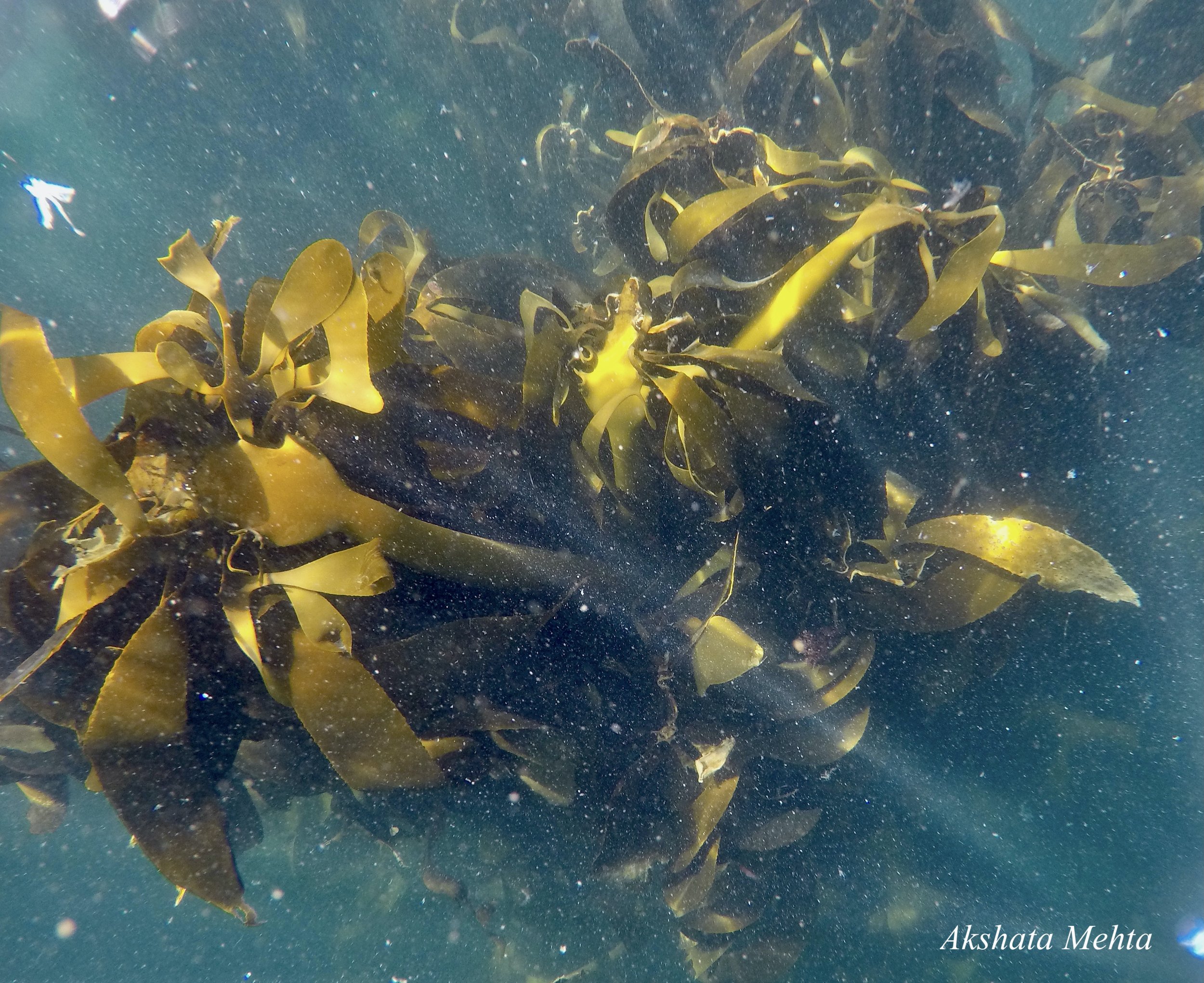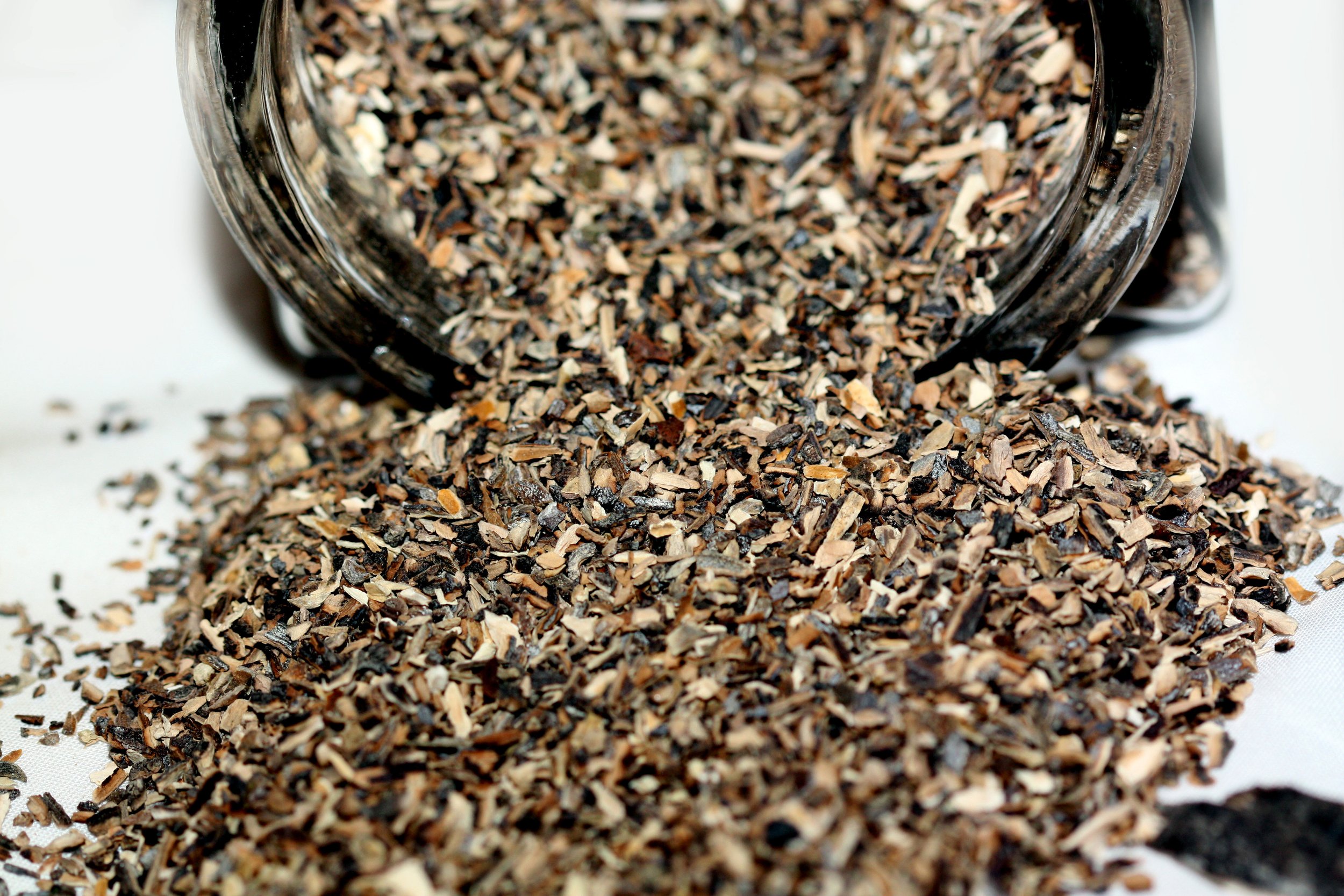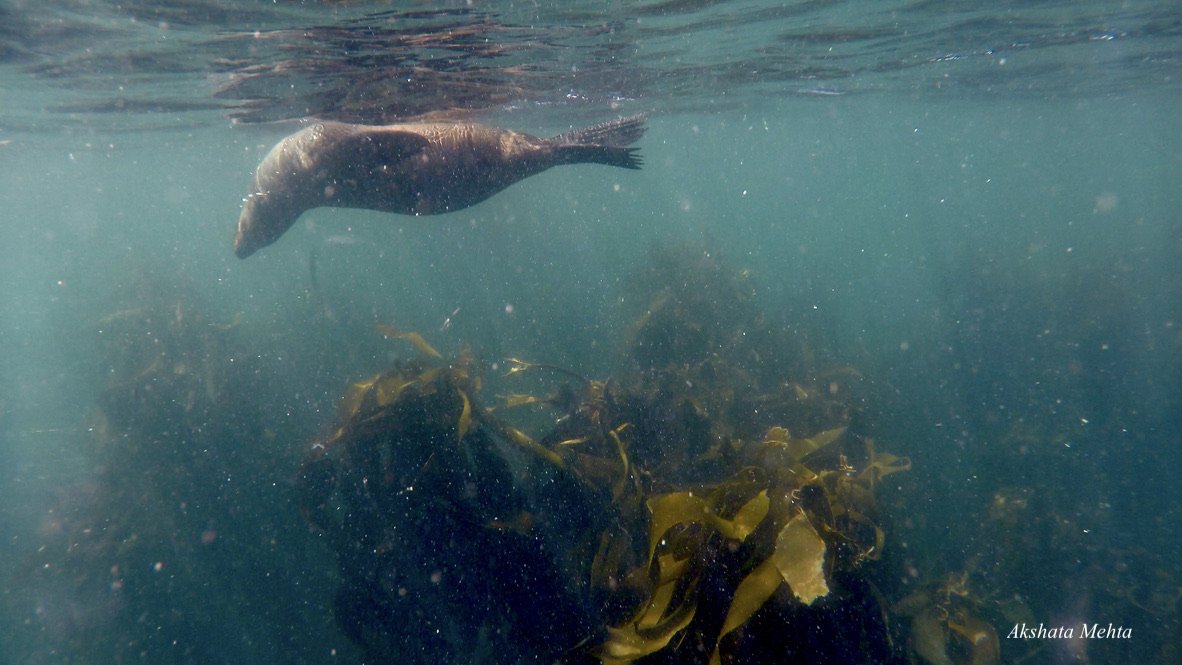Kelp (Ecklonia Maxima, Laminaria Pallida)
Kelp forests in Western Cape, South Africa. (Photo: Akshata Mehta)
by Akshata Mehta
Background
The common kelp species found in South Africa, specifically in the Cape Peninsula, include Ecklonia maxima (commonly known as sea bamboo), Laminaria pallida (commonly known as split-fan kelp), and Macrocystis pyrifera (commonly known as bladder kelp) (Maneveldt, 2013). Of these, Ecklonia maxima is the largest of local kelp species, and is found in abundance across the inshore regions of the southern and west coast of South Africa. On the other hand, Macrocystis pyrifera is the least common of West Coast kelp species.
Internationally, there is a significant market for the harvesting of kelp to produce alginate — a substance used as a gelling and emulsifying agent. Alginate has a vast variety of applications, namely in the food industry, cosmetics industry, paint and welding industries, and the medical industry. Outside of alginate production, kelp is also used in fertilizers, as a nutritional supplement for farm animals, in plant-growth enhancers, and in abalone feed (Maneveldt, 2013).
The utilization and management of kelp as a wild food resource can be viewed through two lenses: the commercial sector and subsistence and/or recreational fishery. Of these, the commercial kelp sector is more prominent in South Africa. Even so, the commercial trade of kelp as a wild food has not always benefitted local communities beyond the employment of local peoples.
Commercial kelp sector
The commercial seaweed sector in the Western Cape is based on the beach-cast collection of kelp and the ocean-based harvesting of kelps. Fresh beach-cast kelp is collected mostly for abalone feed, while dry beach-cast kelp (i.e., washed-up kelp that is then dried and milled into chips) is used for export, mainly to Asia, after which alginate is then extracted from it to be used in various applications (e.g., medicines, gelling agents).
The dominant kelp species used for commercial purposes are Ecklonia maxima and to a lesser extent, Laminaria pallida (DAFF, 2013). Macrocystis pyrifera is not used for commercial purposes in the Western Cape as its natural population is too small to warrant harvesting (Maneveldt, 2013). Currently, kelp in South Africa is managed under the Marine Living Resources Act (MLRA) of 1988, administered by the Department of Forestry, Fisheries, and the Environment (DFFE). The South African coastline area where seaweed occurs is divided into 23 Seaweed Rights Concession Areas (SRCAs) and seaweed concession rights are currently allocated to harvesting and collection entities for a period of 15-years.
Dried and milled kelp "chips". These are baled in 20kg bags and exported for alginate extraction. (Photo: Taurus Chemicals Cape Kelp)
Historically, these concession permits were only issued to large-scale commercial entities. As of 2016, however, DFFE also introduced a ‘Small-Scale Fishing Policy’ (SSFP), aimed at including small-scale fishers in the SRCA application process. These fishers were previously unable to obtain seaweed concession rights due to their inability to compete with larger commercial entities. Seaweeds were included in the group of resources to which certain small-scale fishers would be given rights (Rothman et al., 2020). As a result, in 2017, many SRCAs were not assigned to commercial entities, but were provisionally allocated to small scale fishers under the SSFP. However, even after this policy introduction and provisional allocation, the small-scale fisheries sector has not yet been fully activated, for unknown reasons (Rothman et al., 2020). This delay has led to a pause in the harvesting of beach-cast kelp in areas provisionally allocated to small scale fishers after 2016. Ultimately, the temporary solution put in place by DFFE was to give previous rights holders (i.e., large-scale commercial entities) exemptions to continue harvesting in these provisionally allocated areas. As a result, the small-scale commercial harvest of kelp remains virtually non-existent (Rothman et al., 2020).
As the system currently stands, even if small-scale fishers were able to obtain kelp concession permits, a systemic failure has occurred in that these fishers would not have the capacity or means to harvest kelp and compete with larger commercial entities. As a result, these fishers are dependent on employment by larger commercial entities that can retain permits to harvest kelp — as commercial entities have access to infrastructure that enables large-scale harvesting — whereas small-scale fishers simply do not due to their positional disadvantages.
Inappropriate legal mechanisms to operationalize small-scale fishing policy paired with the lack of consideration for the inability of small-scale fishers to compete with larger entities has resulted in policy implementations that are not suited to the unique small-scale fisher context (Sowman & Sunde, 2021).
In this way, the commercial trade and resulting export of kelp (mostly for the purpose of alginate production) does not benefit local people in terms of profits, nor rights to access due to the many entry barriers (lack of capital, lack of machinery, reduced expertise, etc.) into the commercial kelp sector. Seemingly, the main benefit for local people from coastal communities are employment opportunities — mostly at the beach-cast kelp harvester/boat harvester level— and the resultant livelihoods provision. Beyond these, greater benefits to the local community are not achieved due to the positional, legal, and financial reasons such as the ones mentioned above.
A Cape fur seal glides over kelp in the Western Cape. (Photo: Akshata Mehta)
Subsistence and Recreational fishery
Today, there is little to no subsistence and/or recreational fishery of kelp in South Africa. This is due both to economic reasons and the fact that local seaweed and kelp are rarely eaten in South Africa (DFFE, 2013). As such, the kelp industry is sophisticated and requires large initial investments in the form of vehicles, boats, storage space and facilities for kelp processing. Additionally, as noted by DFFE, dried kelp sometimes has to be stored until international markets warrant its sale, resulting in an industry that may not be highly profitable. As a result, is seems that harvesting kelp in South Africa remains a commercial operation, with essentially no subsistence fishery and little recreational use (DFFE, 2013).
However, social media and media publications with those passionate about kelp paint another picture. A handful of local entities (e.g., The Kelp Shack, Veld and Sea) who are involved with kelp claim that historically, kelp was commonly used for subsistence by Indigenous coastal dwellers in South Africa. Today, these entities conduct kelp foraging experiences, advocating for the use of sustainably foraged kelp as wild food, in the form of lasagne, kelp pickles, kelp falafel and more. More research is needed to understand this burgeoning trend, and whether/how it affects subsistence and recreational use of the resource. This is especially important given the lack of resource rights (resulting from limited capacities) assigned to small-scale fishers, as noted in the section above.
Click here to download a summary table of the case study.
References
Anderson, R. & Rothman, M. The Guide to Kelp Harvesting in South Africa. Department of Agriculture, Forestry and Fisheries. Republic of South Africa. Available here.
Blamey, L.K. & Bolton, J.J. 2018. The economic value of South African kelp forests and temperate reefs: Past, present and future. Journal of Marine Systems, 188: 172–181. Available here.
Bolton, J. & Blamey, L. 2017. Kelps in southern Africa are thriving, but some key inhabitants of kelp forests are not. The Conversation. Available here.
DAFF. 2013. Description of the commercial seaweed sector.
DFFE. 2015. Government Gazette Staatskoerant.
DFFE. 2013. Description of The Commercial Seaweed Sector.
Filbee-Dexter, K. & Wernberg, T. 2018. Rise of Turfs: A New Battlefront for Globally Declining Kelp Forests. BioScience, 68:64–76. Available here.
Kassinger, R. 2019. Slime: How Algae Created Us, Plague Us, and Just Might Save Us. Mariner Books.
Louw, M. 2020. Wild food foraging back in fashion in South Africa. CNN Travel. Available here.
Maneveldt, G. 2013. An Introduction to Sea Plants.
Rothman, M.D., Anderson, R.J., Kandjengo, L. & Bolton, J.J. 2020. Trends in seaweed resource use and aquaculture in South Africa and Namibia over the last 30 years. Botanica Marina 63,315–325. Available here.
Sowman, M. & Sunde, J. 2021. A just transition? Navigating the process of policy implementation in small-scale fisheries in South Africa. Marine Policy, 132: 104683. Available here.



